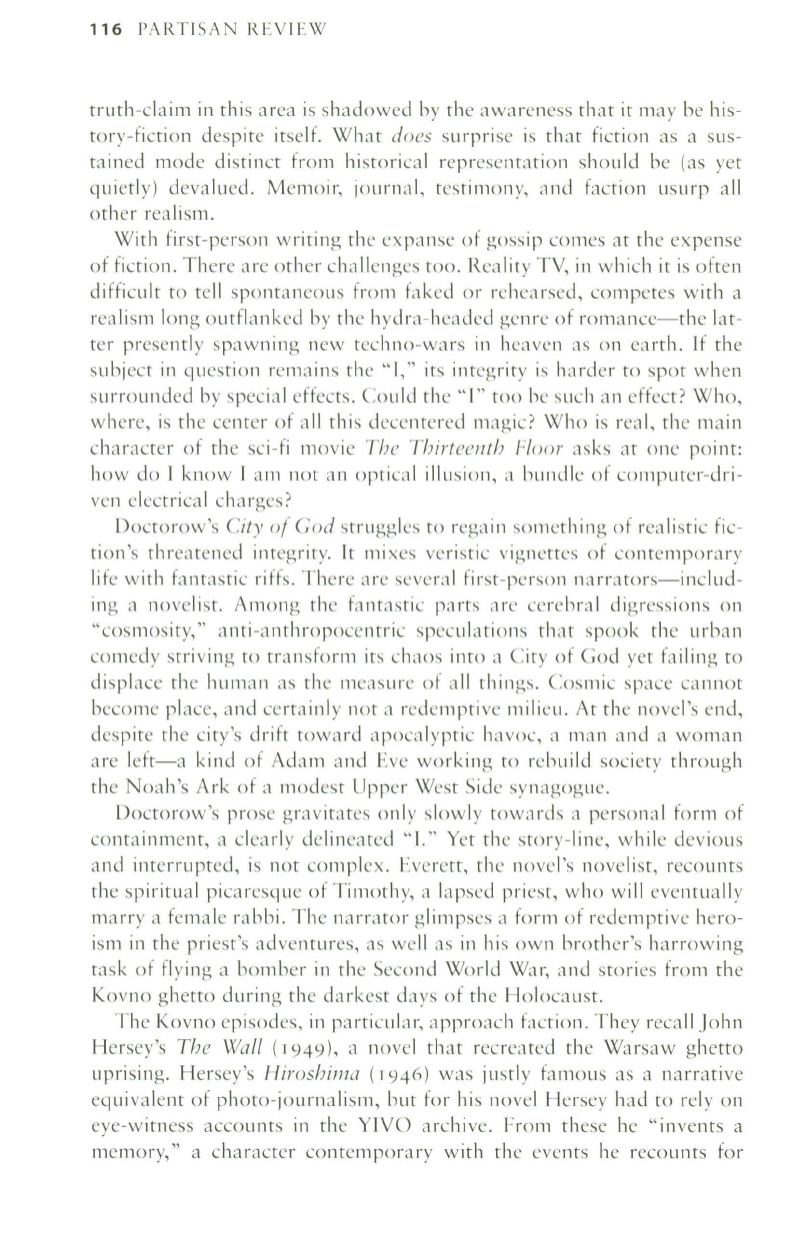
116
PARTISAN REVIEW
truth-claim in this area is shadowed hy the awareness that it may be his–
tory-fiction despite itself. What
does
surprise is that fiction as a sus–
tained mode distinct from historical representation should be (as yet
quietly) devalued. Memoir, journal, testimony, and faction usurp all
other realism.
With first-person writing the expanse of gossip comes at the expense
of fiction. There are other challenges too. Reality TV, in which it is often
difficult to tell spontaneous from faked or rehearsed, competes with a
realism long outflanked by the hydra-headed genre of romance-the lat–
ter presently spawning new techno-wars in heaven as on earth.
If
the
subject in question remains the "I," its integrity is harder to spot when
surrounded by special effects. Could the "I" too he such an effect? Who,
where, is the center of all this decentered magic? Who is real, the main
character of the sci-fi movie
The Thirteenth Floor
asks at one point:
how do I know I am not an optical illusion, a hundle of computer-dri–
ven electrical charges?
Doctorow's
City of God
struggles to regain something of realistic fic–
tion's threatened integrity.
It
mixes veristic vignettes of contemporary
life with fantastic riffs. There are several first-person narrators-includ–
ing a novelist. Among the fantastic parts are cerehral digressions on
"cosmosi ty," a nti-a nth ropocentric specu la tions that spook the urban
comedy striving to transform its chaos into a City of God yet failing to
displace the human as the measure of all things. Cosmic space cannot
become place, and certainly not a redemptive milieu. At the novel's end,
despite the city's drift toward apocalyptic havoc, a man and a woman
are left-a kind of Adam and Eve working to rebuild society through
the Noah's Ark of a modest Upper West Side synagogue.
Doctorow's prose gra vita tes on Iy slowl y towa rds a persona I form of
containment, a clearly delineated
"I."
Yet the story-line, while devious
and interrupted, is not complex. Everett, the novel's novelist, recounts
the spiritual picaresque of Timothy, a lapsed priest, who will eventually
marry a female rabbi. The narrator glimpses a form of redemptive hero–
ism in the priest's adventures, as well as in his own brother's harrowing
task of flying a bomber in the Second World War, and stories from the
Kovno ghetto during the darkest days of the Holocaust.
The Kovno episodes, in particular, approach faction. They recall John
Hersey's
The Wall
(1949),
a novel that recreated the Warsaw ghetto
uprising. Hersey's
Hiroshima
(1946)
was justly famous as a narrative
equivalent of photo-journalism, but for his novel Hersey had to rely on
eye-witness accounts in the YIVO archive. From these he "invents a
memory," a character contemporary with the events he recounts for


